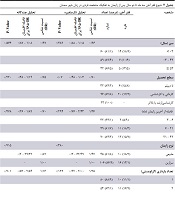Koomesh
Journal of Semnan University of Medical Sciences

Image Credit:Koomesh
Outlines
Is Iron Supplementation In Health Centers Until the End of the Breastfeeding Period Necessary?
Author(s):
1Abnormal Uterine Bleeding Research Center, Semnan University of Medical Sciences, Semnan, Iran
2Research Committee of Semnan University of Medical Sciences, Semnan, Iran
3Social Determinants of Health Research Center, Semnan University of Medical Sciences, Semnan, Iran
How to Cite:Rahbar N, Karami K, Ghorbani R. Is Iron Supplementation In Health Centers Until the End of the Breastfeeding Period Necessary?.koomesh.2024;26(2):e150078.https://doi.org/10.69107/koomesh-150078.
Abstract
References
- 1.Jameson JL, Fausi AS, Kasper DL, Hauser SL, Longo DL, Loscalzo J. Harrison's Principles of Internal Medicine. New York: McGraw-Hill; 2018. p. 683-90.
- 2.Butwick AJ, McDonnell N. Antepartum and postpartum anemia: a narrative review. Int J Obstet Anesth. 2021;47:102985. [PubMed ID:33893005]. https://doi.org/10.1016/j.ijoa.2021.102985.
- 3.Mirza FG, Abdul-Kadir R, Breymann C, Fraser IS, Taher A. Impact and management of iron deficiency and iron deficiency anemia in women's health. Expert Rev Hematol. 2018;11(9):727-36. [PubMed ID:30019973]. https://doi.org/10.1080/17474086.2018.1502081.
- 4.Bodnar LM, Cogswell ME, Scanlon KS. Low income postpartum women are at risk of iron deficiency. J Nutr. 2002;132(8):2298-302. [PubMed ID:12163678]. https://doi.org/10.1093/jn/132.8.2298.
- 5.World Health Organization. Guideline: Iron supplementation in postpartum women. 2016. Available from: https://iris.who.int/bitstream/handle/10665/249242/9789241549585-eng.pdf?sequence=1&isAllowed=y.
- 6.Abdolahi Z, Dorosti AR, Falah H, Bakhshandeh M, Torabi P, Rahmani K, et al. [Comprehensive nutrition guide for pregnant and lactating mothers]. 2nd ed. Qom: Andesheh Mandegar; 2014. p. 67-9.
- 7.Henjum S, Manger M, Skeie E, Ulak M, Thorne-Lyman AL, Chandyo R, et al. Iron deficiency is uncommon among lactating women in urban Nepal, despite a high risk of inadequate dietary iron intake. Br J Nutr. 2014;112(1):132-41. [PubMed ID:24708993]. https://doi.org/10.1017/S0007114514000592.
- 8.Rakesh P, Gopichandran V, Jamkhandi D, Manjunath K, George K, Prasad J. Determinants of postpartum anemia among women from a rural population in southern India. Int J Womens Health. 2014;6:395-400. [PubMed ID:24748821]. [PubMed Central ID:3990363]. https://doi.org/10.2147/IJWH.S58355.
- 9.Rahbar N, Ghorbani R. [Prevalence of anemia, iron deficiency and iron deficiency anemia three months after delivery in the Iranian women]. Koomesh. 2015;16(4):574-80. Persian.
- 10.Khademi Z, Shahi A, Farshid Far GR, Zare S, Vaziri F. [Prevalence of iron deficiency anemia in pregnant women referred to shariati hospital in Bandar Abbas, Iran]. Hormozgan Med J. 2004;8(1):27-31. Persian.
- 11.Zewdu D, Tantu T, Ali R, Demissie H, Baboker P, Daniel Z, et al. Prevalence and predictors of postpartum anemia after caesarean delivery in Ethiopia: A retrospective analysis of risk factors. Midwifery. 2023;123:103707. [PubMed ID:37187101]. https://doi.org/10.1016/j.midw.2023.103707.
- 12.Davidson EM, Scoullar MJL, Peach E, Morgan CJ, Melepia P, Opi DH, et al. Quantifying differences in iron deficiency-attributable anemia during pregnancy and postpartum. Cell Rep Med. 2023;4(7):101097. [PubMed ID:37413986]. [PubMed Central ID:10394161]. https://doi.org/10.1016/j.xcrm.2023.101097.
- 13.Bodnar LM, Cogswell ME, McDonald T. Have we forgotten the significance of postpartum iron deficiency? Am J Obstet Gynecol. 2005;193(1):36-44. [PubMed ID:16021056]. https://doi.org/10.1016/j.ajog.2004.12.009.
- 14.Jalali M, Siassi F, Ghiasvand R, Jarollahi N, Gheibi F, Fatehi F, et al. [Iron Deficiency Anemia in Pregnant Women in Eslamshahr]. J Kerman Univ Med Sci. 2005;12(2):271-7. Persian.
- 15.Mahmoudi G, Nick Pour B, Khazaee-Pool M, Majlessi F. [The Study of Anemia Prevalence and Some Related Factors among Pregnant Women in Health Centers of Mazanderan in 2015]. Payavard Salamat. 2017;11(3):266-75. Persian.
- 16.Rahbar N, Ghorbani R, Rezaei Ahvanoei F. [Prevalence of iron deficiency anemia and its complications in pregnant women referred to medical-health centers in Semnan]. Iran J Obstet Gynecol Infertil. 2014;17(128):12-7. Persian. https://doi.org/10.22038/ijogi.2014.3694.
- 17.Khanal V, Adhikari M, Karkee R. Low compliance with iron-folate supplementation among postpartum mothers of Nepal: an analysis of Nepal Demographic and Health Survey 2011. J Community Health. 2014;39(3):606-13. [PubMed ID:24322600]. https://doi.org/10.1007/s10900-013-9806-6.
Copyright
© 2024, Author(s). This open-access article is available under the Creative Commons Attribution 4.0 (CC BY 4.0) International License (https://creativecommons.org/licenses/by/4.0/), which allows for unrestricted use, distribution, and reproduction in any medium, provided that the original work is properly cited.
comments
Leave a comment here
Crossmark
Checking
Comments
Number of Comments:0Cited by
Purchasing Reprints
- Copyright Clearance Center (CCC) handles bulk orders for article reprints for Brieflands. To place an order for reprints, please click here ( https://www.copyright.com/landing/reprintsinquiryform/ ). Clicking this link will bring you to a CCC request form where you can provide the details of your order. Once complete, please click the ‘Submit Request’ button and CCC’s Reprints Services team will generate a quote for your review.
Search Relations
Author(s):
Related Articles